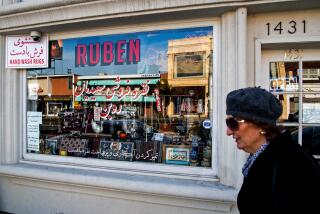With embargo under the rug, Persian carpets can roll into U.S. again

- Share via
The call came in to the rug store at 10:30 on Wednesday morning: After five days in U.S. customs, the first batch of carpets imported from Iran were ready for pickup.
Years of waiting finally ended for Alex Helmi, owner of Damoka, a Persian rug store in Westwood. He quickly gathered his employees and told them to drive to Los Angeles International Airport to pick up the shipment: 40 handmade rugs — some antique, some modern — valued at about $500,000.
“I wanted to cry,” Helmi said.
Helmi has been selling Persian rugs for decades, but this marked the first time he was getting merchandise directly from Iran since the U.S. imposed an embargo on the country in 2010.
The shipment is a small piece of the landmark nuclear accord with Iran that was implemented last month. Under the deal, Iran agreed to dismantle parts of its nuclear program in exchange for the lifting of sanctions that have crippled the nation’s economy.
In Southern California, home to the largest Persian community outside of Iran, the end of the embargo is reinvigorating a commercial lifeline that had gone cold for the nearly six years that imports of famed Persian rugs had been banned. Aside from rugs, merchants hope to import other, lesser-known Iranian delights such as saffron, caviar and pistachios.
“Today is a very special day,” Helmi said, as he fawned over additions to his collection.
Grinning, he grasped one of the plastic-wrapped rugs and tore the white cover apart. Two employees stood by his side as they unrolled a golden carpet decorated with pink flowers and colorful patterns of blue and red. The rugs are being sold for between $10,000 for a smaller rug and $100,000 for a fine, large rug — a premium price since the supply remains tight.
Helmi marveled at the work of art beneath his feet. For hundreds of years, the rugs have been handmade by small groups of weavers and dyed with natural ingredients such as walnut skins, pomegranate and acorn cups. Some rugs take a decade or more to weave. Though many countries produce handmade rugs, those from Iran are considered among the most precious because of the time and materials used.
“It’s a shame to not let this art come to the United States,” he said. “Art never has borders.”
For years, Helmi struggled to replenish a dwindling assortment of older rugs purchased before the embargo. Dealers resorted to selling rugs from other parts of the world. But it was an unsatisfying solution to collectors who prized the craftsmanship of Persian rugs and Iranians who sought a connection not only to their childhood but also to their cultural roots.
Experts say that before the embargo, the U.S. accounted for one-fifth of Iran’s carpet exports.
Included in Helmi’s new shipment were 13 large rugs, some of them more than 100 years old. Most are made of pure silk, he said, though some are a mix of silk and gold-plated thread.
The rug dealer has been waiting for the shipment for nearly six months. When the deal was announced last summer, he called weavers in Iran and told them he wanted to import their carpets the moment sanctions were lifted.
Not all business owners are eager for the effects of the deal to reach U.S. soil.
The West Los Angeles Chamber of Commerce said it refuses to participate in “any business with countries on the State Department’s list of sponsors of terrorism, including the Islamic Republic of Iran.”
Iran’s “anti-American activities” — including the brief detention of U.S. sailors last month — make it an unfit partner in trade, said Roozbeh Farahanipour, the chamber’s president who was born in Iran.
Any company that wants to do business with Iran is not allowed to become a member of the chamber, he said.
“As long as we promote business with the Islamic Republic, we grant legitimacy to the human rights violations of Iran,” Farahanipour said. “It’s the least the Iranian people can do, to not support business with the Islamic Republic.”
Experts add there is always the possibility of a renewed embargo.
“We still have sanctions on the table due to Iran’s sponsorship of terrorism,” said Josh Lockman, an international law professor at USC’s Gould School of Law. “Businesses in Iran will still benefit, but it’s far-fetched to say this is a wide opening. We are a long ways away from the normalization of ties, unless there’s a change in the regime’s behavior.”
But the pent-up demand for products from Iran is high.
At the Jordan Market in Westwood, customers stopped asking about Iranian caviar years ago, when the embargo placed a ban on the delicacy. They scanned the aisles for other tastes of home, such as the pistachios exported from Iran and brought in through Canada.
Now, owner Farid Khanlou is eagerly awaiting the day Iranian caviar hits the market — whenever that may be.
“I have no idea how much it will be, but we will sell it,” said Khanlou, 60.
Caviar harvested from Iranian waters will be much more expensive than its Russian counterpart, he said — at least three or four times the price. But he still expects a brisk market for the product.
“Persian caviar, they sell it in Europe for a few thousand dollars” a can, Khanlou said.
For his part, Helmi said, he hopes lifting sanctions will lead to better relations between Iranians and Americans.
“The people who wove these rugs 100 years ago have nothing to do with politics,” he said.
Helmi and his workers unfurled one new carpet on top of the next, carefully admiring each piece as they formed a pile. The store owner couldn’t help but smile at the mosaic of bright colors before his eyes. The employees were excited too, eager too see a “new breed” of rugs.
By the time their work was done, dozens of gold and ivory rugs covered the floor; others sat stacked in piles or hung on the walls.
Customers have been waiting for new rugs from Iran for months, Helmi said, asking for specific colors and sizes. Many of them plan on checking out the rugs this week, he said.
Helmi plans to keep the shipments coming.
“Finally,” he said, “the doors have opened up.”
Twitter: @sarahparvini
More to Read
Inside the business of entertainment
The Wide Shot brings you news, analysis and insights on everything from streaming wars to production — and what it all means for the future.
You may occasionally receive promotional content from the Los Angeles Times.
![LOS ANGELES, CA - JUNE 17: [Cody Ma and Misha Sesar share a few dishes from their Persian Restaurant Azizam] on Monday, June 17, 2024 in Los Angeles, CA. (Ethan Benavidez / For The Times)](https://ca-times.brightspotcdn.com/dims4/default/7ffc7f6/2147483647/strip/true/crop/5110x3417+306+0/resize/320x214!/quality/75/?url=https%3A%2F%2Fcalifornia-times-brightspot.s3.amazonaws.com%2F79%2Fdc%2F4d29255545f5b9813315901692bc%2F1459972-fo-azizam-review20-eba.JPG)










